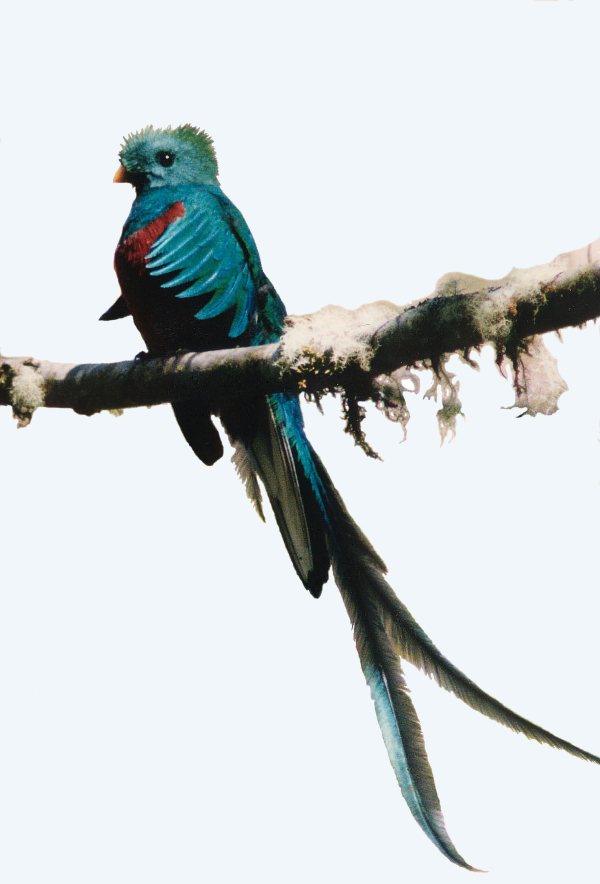
Due to their cloud forest habitat preferences, few people have had the experience of seeing, photographing, and filming a Resplendent Quetzal shimmering in open sunlight.

Ingun Mendez brought a bright smile to the cloud forest amid an exciting combination of birds that inhabit the isthmus bridge that connects the Americas.
|
As we hiked through the lush cloud forest, mist-laden clouds bathed every leaf and permeated the air with an earthen freshness. The sounds of myriad birds, joined by frogs and the electric sounds of insects added another dimension to our hike up the tropical mountainside. Any bird in this forest would hold the attention of birders, but this morning our objective overshadowed all other living beings, for we were in search of what many people consider to be the most beautiful of all birds in the world – a male Resplendent Quetzal.
When we entered an opening in the green curtain, the birdman of Panama, Hernan Arauz, stopped in his tracks and raised his hand to alert us that a bird of import was ahead of us. We were in the company of a Panamanian television crew who were hoping to make a Quetzal and our quest for this avian icon the centerpiece for a popular television program, so there was an added level of excitement today.
Hernan pointed in a 120-degree angle upward where our eyes were drawn to a reflection in a small opening where rays of sunlight penetrated the dense jungle canopy. There, glimmering as the morning light broke through the veil of clouds and fog, was a fabled Resplendent Quetzal.
Wow! Viewing the Quetzal through 10x binoculars, it was easy to understand that this is one of the most beautiful of all birds and that it is also one of the most sought-after birds for birders to see. To photo-graph a full-plumaged male with its long pendant tail feathers in perfect morning light was almost too much to imagine, for Quetzals are also one of the most sought-after birds for photographers. However, because of the dense forests that Quetzals inhabit, few people ever get a chance to photograph these amazing birds in sunlight due to a lack of light in the deep jungle shadows beneath the usual cloud cover.
Now, bathed in the light of the morning sun, the normally green plumage of the Resplendent Quetzal turned a radiant turquoise color that shimmered iridescent blue, green, gold, and even violet at times. Even in a relaxed position, the bird seemed to be displaying, or at least posing, in its glorious – make that resplendent – plumage. No color could set off the iridescent turquoise-green more vividly than the deep red of the Resplendent Quetzal’s breast plumage. Its unique crest, short bill, and long filamentous tail feathers that drifted daintily in the lightly shifting breeze added detailed highlights to the Quetzal’s beauty.
This Resplendent Quetzal was exceptionally trusting, for although we were especially careful not to alarm the bird, after a short time we realized the remarkable Quetzal accepted us into its realm without concern. This individual would become a true ambassador of the cloud forest and all the birds of Panama, through the television video and my own still photographs that I would publish. What a great opportunity! And what a memorable experience during our first morning in the heart of northwest Panama’s cloud forest.
This outstanding destination is located within the International Friendship Park that straddles Panama’s northwest border with Costa Rica. This highland region provided a memorable parade of tropical birds, including Emerald Toucanets, Flame-throated Warblers, Collared Redstarts, Ruddy Treerunners, Spot-crowned Woodcreepers, and Prong-billed Barbets. Their names alone are so exotic, but one familiar bird also made an appearance to bridge the expanse between this cloud forest and my own yard – we sighted a Hairy Woodpecker here at the southern limit of the species’ range.
Our lodge, appropriately named Los Quetsales, was a beautiful two-story, all-inclusive, modern facility that made a visit to this Quetzal haven all the more enjoyable. There, Hernan and I were interviewed by the television program hosts, my friend Ricardo de la Espriella and his co-host Ingun Mendez, who we shared the Quetzal experience with earlier in the day. Nearby our informal TV set, the lodge’s hummingbird feeders attracted an interesting, if not baffling, assortment of five species of hummingbirds, including Magnificent Hummingbirds, White-throated Mountain Gems, Violet Sabrewings, Stripe-tailed Hummingbirds and one of the smallest of all – Volcano Hummingbirds. These fast, minute birds sped about back and forth from the feeders, even offering some photo opportunities.
Panama is the obvious link between North America and South America, and it likewise links the distribution of “northern” species, including wintering warblers and orioles with southern species such as big macaws and tropical tanagers. Panama offers a wildlife wonderland unmatched in North America and rarely rivaled to the south with a species list of more than 1,000, especially expansive for such a small country. Panama is a nation that I will always appreciate as a world-class birding destination and this particular trip that took me from the border of Costa Rica to the border of Columbia will always stand out among my favorites.
Article and photographs by Paul Konrad
Share your birding experiences and photos at editorstbw2@gmail.com